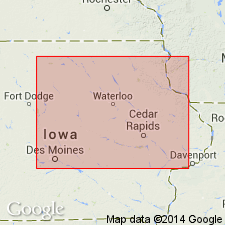
- Usage in publication:
-
- Pinicon Ridge Formation
- Modifications:
-
- Named
- Dominant lithology:
-
- Dolomite
- Limestone
- Gypsum
- Anhydrite
- AAPG geologic province:
-
- Iowa shelf
Summary:
Named as the upper formation of the Wapsipinicon Group (rank raised) for exposures--the type locality--at Pinicon Ridge Park, northwest Linn Co, IA on the Iowa shelf. Recognized in northern and east-central IA. Overlies Spillville Formation of Wapsipinicon Group. Disconformably underlies Solon or Bassett Member of Little Cedar Formation (new) of the Cedar Valley Group. Divided into (ascending): Kenwood, Spring Grove, and Davenport Members, all previously named members of Wapsipinicon Formation. Dominated by carbonate rock (thin-bedded, nonfossiliferous, argillaceous to shaly dolomite, thin- to medium-bedded dolomite, and dense limestone). Has some gypsum and anhydrite. Ranges between 20 to 40 m thick. Its stratigraphic position suggests late Eifelian and early Givetian or Middle Devonian age. Is nonfossiliferous. Widespread subtidal deposition in a restricted seaway suggested for some parts of formation. Other parts of formation deposited in intertidal, supratidal, sabkha, and lagoonal environment. Graphic lithologic sections. Nomenclature charts.
Source: GNU records (USGS DDS-6; Denver GNULEX).
For more information, please contact Nancy Stamm, Geologic Names Committee Secretary.
Asterisk (*) indicates published by U.S. Geological Survey authors.
"No current usage" (†) implies that a name has been abandoned or has fallen into disuse. Former usage and, if known, replacement name given in parentheses ( ).
Slash (/) indicates name conflicts with nomenclatural guidelines (CSN, 1933; ACSN, 1961, 1970; NACSN, 1983, 2005, 2021). May be explained within brackets ([ ]).

